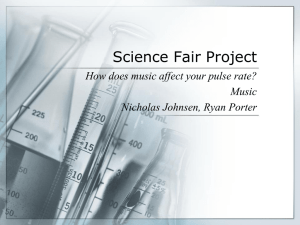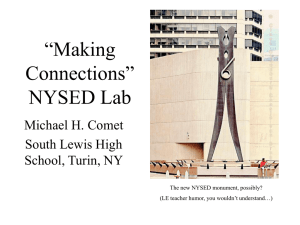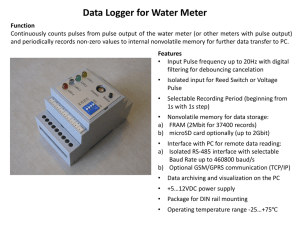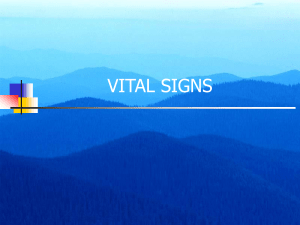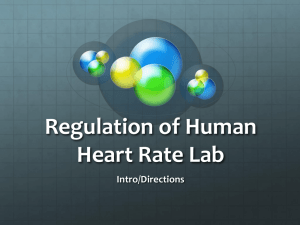PPT
advertisement
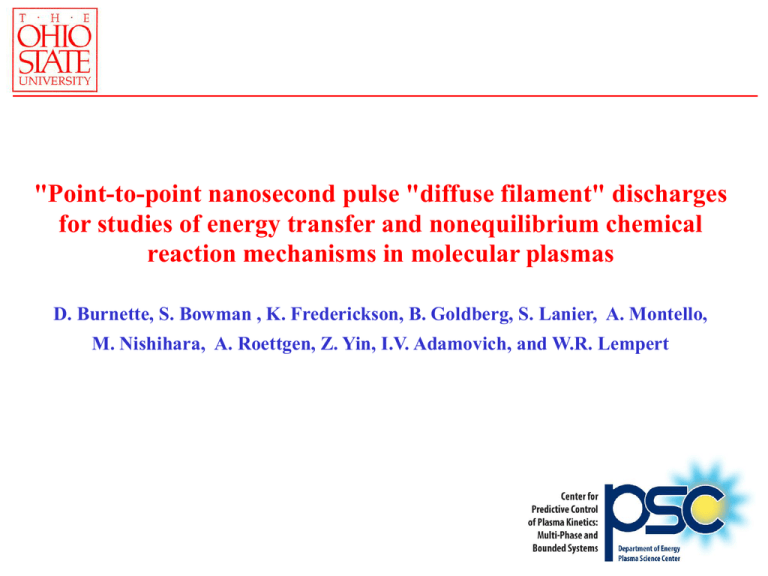
"Point-to-point nanosecond pulse "diffuse filament" discharges for studies of energy transfer and nonequilibrium chemical reaction mechanisms in molecular plasmas D. Burnette, S. Bowman , K. Frederickson, B. Goldberg, S. Lanier, A. Montello, M. Nishihara, A. Roettgen, Z. Yin, I.V. Adamovich, and W.R. Lempert Objective / Outline Main thrust: isolating molecular energy transfer processes and reaction pathways in nonequilibrium, high-pressure, highly transient molecular plasmas • Previous results in plane-to-plane nsec pulse discharges • Point-to-point nsec pulse discharges to achieve high specific energy loadings • Vibrational level populations and temperature measurements by psec CARS: results for nitrogen and air • CARS and spontaneous Raman spectroscopy results analysis, comparison with kinetic modeling: do we understand kinetics mechanisms involved? • Overview of absolute species concentrations measurements in reacting air plasmas: NO LIF, O and N atom TALIF • Path to measuring both reactant and product species in vibrationally enhanced plasma chemical reactions • Electric field measurements of in nsec pulse discharges by 4-wave mixing • Work in progress: development of electron density measurements by Thomson scattering Previous results: repetitive nanosecond pulse discharge in plane-to-plane geometry (6.3 cm x 2.2 xm x 1 cm, ~25 kV, ~10 nsec pulses, pulse rep rate 10 kHz) Air, T0=300 K, P=50 torr, Pulse #10 Air Pulse #1 Pulse #10 Pulse #100 T0=300 K P=60 torr T0=300 K P=120 torr T0=500 K P=200 torr Side view (0.5 nsec gate) End view (50 nsec gate) Preheating enhances diffusion and thermal conductivity, greatly improves plasma uniformity Instability onset is not controlled by reduced electric field, E/N Kinetic modeling: coupled master equation / Boltzmann equation model of nonequilibrium air plasma dnv (t ) ( El . imp ) v (VT ) v (VV ) v (VE ) v (V Chem ) v dt RHS terms represent vibrational quantum state change by the following processes: El. Imp.: inelastic electron impact processes by free electrons VT: vibration-to-translation/rotation energy relaxation VV: vibration-to-vibration energy exchange VE: electronic-vibration energy transfer during collisional quenching V-Chem: vibrational – chemistry coupling for vibrationally enhanced reactions such as N2(v) + O → NO + N, O2(v) + N → NO + O • Rotational and translational modes are in equilibrium at a gas kinetic temperature • Single vibrational quantum change processes dominate at low temperatures involved • Significant body of theory and experimental validation data for the rates used • Master equation coupled to Boltzmann equation for electron energy distribution, species concentrations equations, and quasi-1-D compressible flow equation • Nonequilibrium air plasma chemistry, excited electronic states kinetics are included • 0-D, with correction for diffusion • E/N, ne waveforms predicted by separate nsec pulse, plane-to-plane discharge model Excitation of air by nsec pulse discharge burst: Psec CARS measurements, master equation modeling • Dry air, P=100 torr, T0=300 K, burst of 100-150 pulses, repetition rate 10 kHz • Trot, Tv(N2) measurements by psec CARS • ~40% of coupled energy is loaded into N2 vibrational mode • Model predicts N2(X,v) populations, electron impact / vibrationally stimulated reaction products • Vibrational relaxation mainly by O atoms, ozone • Specific energy loading fairly low, ~1 meV/molecule/pulse • Temperature rise ~ 1 K/pulse, Tv(N2) remains fairly low New Test Bed: Diffuse Filament Nsec Pulse Discharge between two bare metal spherical electrodes Use of small (a few mm diameter), bare spherical electrodes increases power loading (up to ~1 eV/molecule/pulse at P=100 Torr, coupled pulse energy up to ~10-20 mJ) AND creates plasma large enough to be easily probed by CARS, spontaneous Raman spectroscopy, and two-photon absorption LIF (TALIF) 4 mm 2 mm 10 mm Air, single-pulse nsec pulse discharge: 100 ns gate, during the pulse (left) and 1 μsec after the pulse (right) Air, single-pulse nsec pulse discharge in point-to-point geometry: schlieren images and waveforms Compression waves formed by “rapid” heating, on subacoustic time scale From known initial temperature & pressure, voltage, current, and filament diameter → Reduced electric field (E/N) and electron density (ne) for kinetic modeling Psec BOX-CARS using broadband dye mixture: good spatial and time resolution, access to multiple vibrational levels Ekspla Nd:YAG laser - ~150 psec pulses, 125 mJ per pulse max @ 532 nm Modeless Psec Dye Laser -Broadband ~592-610 nm FWHM, ~7-10% conversion -Broadband Pyrromethene Dye Mixture Folded Box-CARS CARS signal beam Interrogation volume (*S. Tedder, et al, 2011) Spectral Resolution ~0.4 cm-1 95% of signal generated over ~0.5 mm 95% region Data Gaussian Fit Integrated Signal Intensity [au] 3 2.5 2 1.5 1 0.5 0 -0.4 -0.2 0 0.2 Distance [mm] 0.4 Typical psec CARS Spectra, 100 torr N2 (Normalized to v=0, corrected for dye laser spectral profile) 100 laser “shot” averaged spectra vs. time after rising edge of current pulse Vibrational level populations inference: least squares fitting to Voigt line shape v=0 ↓ t = 200 nsec v=3 ↓ v=6 v=9 ↓ ↓ t = 200 nsec (zoomed) v=0-9 are detected Direct evidence of additional N2 vibrational excitation after discharge pulse t = 200 nsec t = 100 μsec Square root of integrated band CARS signal proportional to difference in vibrational level populations, nv –nv+1 Spatial resolution: “1st level” Tv(N2) measurements, 100 torr N2 at a lower pulse energy (5 mJ/pulse) Tv 01 v lnn0 n1 2 mm 10 mm N2, single-pulse nsec pulse discharge in point-to-point geometry, 100 ns gate N2 “first level” vibrational temperature distribution 100 μs after the pulse Rotational Temperature Measurements Data Tfit=300K 25 Tfit =302 K 20 150 Counts Sqrt(Int.) [au] 200 100 15 10 50 0 5 2320 2325 2330 -1 Raman Shift [cm ] 100-shot accumulation spectrum in “cold” 100 torr air, with Sandia CARSFIT best fit synthetic spectrum. 0 280 290 300 Tfit [K] 310 320 Histogram plot from measuring and fitting 80 such spectra. 95% confidence interval ~ ± 9 K. CARS results summary: time-resolved N2 vibrational populations in nitrogen Significant vibrational excitation after the pulse (~100 nsec long), followed by eventual relaxation Energy appears to come to N2(v=1-8) from an “internal storage”, not from electron impact during the discharge Increase in both “first level” N2 vibrational temperature, Tv01, and total number of quanta per molecule, Q Tv 01 v lnn0 n1 9 Q vfv v 0 CARS results summary: time-resolved N2 vibrational populations in air Significant vibrational excitation after the pulse (~100 nsec long), followed by eventual relaxation Energy appears to come to N2(v=1-8) from an “internal storage”, not from electron impact during the discharge Increase in both “first level” N2 vibrational temperature, Tv01, and total number of quanta per molecule, Q Tv 01 v lnn0 n1 9 Q vfv v 0 Air, experiment vs. model: number of vibrational quanta per molecule Average number of vibrational quanta per molecule (Nquanta): 9 N quanta vfv v 0 • Significant increase of number of vib. quanta per molecule ~1-10 μs after the pulse (by ~60%) • At variance with the model, which predicts Nquanta=const after the pulse (V-V exchange conserves quanta) Air, experiment vs. model: N2(X,v) vibrational level populations The VDF evolution can be divided into 3 phases: (1) Initial appearance and growth of all vibrational levels observed (Δt ~ 100 nsec – 1 μsec) (2) Steady growth of vibrational levels detected (Δt ~ 1 μsec – 100 μsec) (3) Vibrational energy decay: V-T relaxation (by O atoms) and diffusion (Δt ~ 100 μsec – 10 msec) As time evolves, v=0, 1 level populations are well predicted by model; higher level populations are significantly underestimated. Tv01(N2) is not a good metric. N2, experiment vs. model: number of vibrational quanta per molecule Average number of vibrational quanta per molecule (Nquanta): 9 N quanta vfv v 0 • Significant increase of number of vib. quanta per molecule ~1-10 μs after the pulse (by more than a factor of 2) • At variance with the model, which predicts Nquanta=const after the pulse (V-V exchange conserves quanta) N2, experiment vs. model: N2(X,v) vibrational level populations N2, experiment vs. model: Tv01(N2) and T Tv 01 v lnn0 n1 Tv01(N2) rise is primarily due to N2–N2 V-V exchange during relaxation: v=0, w → v=1, w-1 CARS results summary: time-resolved rotational/ translational temperature in nitrogen vs. air • Both in N2 and air, model overpredicts “rapid” heating , likely N2(A,B,C,a) + M → N2(X,v) + M (E-V processes) • In air, also model underpredicts “slow” heating (absent in N2), likely V-T relaxation by O: N2(X,v) + O → N2(X,v-1) + O and O atom recombination: O + O + M → O2 + M Where is the energy coming from? Effect of possible electronic-to-vibrational energy coupling in N2 30% energy into N2(X,v) during N2*(A,B,C,a) quenching, e.g. N 2 (C ) N 2 ( X ) N 2 ( B) N 2 ( X , v) N 2 ( A) N 2 ( A) N 2 ( B, C ) N 2 ( X , v) k ( v) k (T )1 exp( )exp v vib (v ) k ( v ) v k (T ) α – adjustable parameter controlling energy into vibrational mode, vib Better agreement of N2 vibrational and rotational temperature with the data Where is the energy coming from? Effect of possible electronic-to-vibrational energy coupling in N2 N2(v=1-8) rise at t ~ 0.1-1 μsec overpredicted, but better agreement at quasi steady state Spontaneous Raman spectroscopy: consistent with psec CARS results (nitrogen, N2(v=0-12), P=100 torr) Signal collection region (2.75 mm) 5 μs delay Integrated band Raman signal proportional to vibrational level population, nv More vibrational levels detected Effect of vibrational quanta rise after discharge pulse observed again Spontaneous Raman results in N2 vs. “baseline” kinetic model predictions Again, N2(v=2-5) rise at t ~ 1-10 μsec is not reproduced by the model Model clearly missing electron impact excitation processes of N2(v>8) Can electron impact excitation processes, N2(v) + e → N2(w) + e (v≥0, w>8) , be the key? Spontaneous Raman results in N2 vs. modified model predictions (30% of energy defect to N2(X,v) during E-V transfer) Better agreement with data at t ~ 1 μsec – 1 msec Previous work: NO LIF Previous and current work: calibrated N and O TALIF Air, 60 torr, plane-to-plane, ~0.3 meV/molecule Mole fractions Mole Mole fractions fractions 1.0E-4 1.0E-4 1.0E-41.0E-4 Air, 40 torr, plane-to-plane, ~6 meV/molecule (21 pulses) O, NO O O O NO O NO ONO O 1.0E-5 1.0E-5 1.0E-5 1.0E-5 NO 1.0E-6 1.0E-6 N NNO O3 ON3 N2(A) NO23(A) O2(b) 1.0E-6 1.0E-6 O NO NO2 (A) ON22(b) (b) NO (X,v) N2(X,v) 22 - (X,v) eN 2 1.0E-7 1.0E-7 1.0E-7 1.0E-7 1E-6 1E-5 1E-4 1E-3 1E-2 1E-1 1E+0 NO2 Time, seconds 1E-6 1E-6 1E-5 1E-5 1E-4 1E-4 1E-3 1E-3 1E-2 1E-2 1E-1 1E-1 1E+0 1E+0 N2, 124 torr, point-to-point, ~60 meV/molecule [NO] prediction including reaction Time, Time, seconds seconds N2(X,v≥12) + O(3P) NO + N Psec CARS (spontaneous Raman), NO LIF, and calibrated TALIF diagnostics: Reactants, products, and temperature can be measured for the same experimental conditions, state-specific reactant rates can be inferred. N Sub-nsec resolution electric field measurement in hydrogen by CARS-like 4-wave mixing E-Field Results (kV/cm) 10 Hydrogen, P=100 torr, L=10 mm gap Line: high voltage probe 8 Symbols: CARS 6 4 2 -0.2 0 0.2 seconds 0.4 0.6 Field in the range of the 1-10 kV/cm has been measured (averaging over 128 discharge pulses) Thomson Scattering for electron density measurements Triple Grating Spectrometer Schematic*,** Mask ↓ * Patterned after Y. Noguchi, et al., Jpn. J. Appl. Phys 40, 2001 ** Acknowledgement: U. Czarnetzki, Ruhr-University Bochum Summary • Time-resolved, spatially resolved T, Tv(N2), and N2 (X,v=0-12) population measurements (psec CARS, spontaneous Raman) in high energy loading nsec pulse discharges in air and nitrogen • Results suggest coupling between electronic and vibrational mode energies in N2 • Time-resolved, spatially resolved measurements of absolute species concentrations in reacting air plasmas: NO (LIF), O and N atoms (TALIF) • Results demonstrate feasibility of measuring both reactant and product species in vibrationally enhanced plasma chemical reactions, N2(X,v≥12) + O(3P) NO + N, inference of state-specific reaction rates • Electric field measurements (4-wave mixing / CARS) in nsec pulse discharges in H2 • Good progress measurements on Thomson scattering diagnostics for electron density • Comprehensive set of optical diagnostics for characterization of nsec pulse discharges in molecular gases


